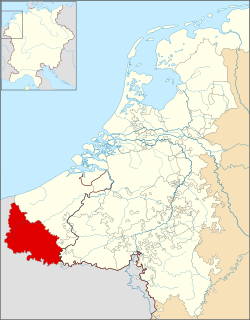
Back كونتية أرتوا Arabic Condáu d'Artois AST Графство Артоа Bulgarian Comtat d'Artois Catalan شارستانی ئارتۆیس CKB Hrabství Artois Czech Grafschaft Artois German Κομητεία του Αρτουά Greek Condado de Artois Spanish Artois' krahvkond Estonian
County of Artois | |||||||||||
|---|---|---|---|---|---|---|---|---|---|---|---|
| 1237–1659 | |||||||||||
 County of Artois (1350) | |||||||||||
| Status | Fiefdom of France, then state of the Holy Roman Empire (1493–1659) | ||||||||||
| Capital | Arras (Atrecht) | ||||||||||
| Common languages | Old Dutch, Middle Dutch, French | ||||||||||
| Government | Feudal system | ||||||||||
| Count of Artois | |||||||||||
• 1237–1250 | Robert I (first) | ||||||||||
• 1404–1419 | John the Fearless (last) | ||||||||||
| Historical era | Middle Ages | ||||||||||
• To France as dowry | 28 April 1180 | ||||||||||
• Count Robert I | 1237 | ||||||||||
• Part of Burgundy | 1384 | ||||||||||
| 1493 | |||||||||||
| 1512 | |||||||||||
| 5 November 1659 | |||||||||||
| |||||||||||
| Today part of | France | ||||||||||

The County of Artois (French: comté d'Artois, Dutch: graafschap Artesië; Picard: Comté d'Artoé) was a historic province of the Kingdom of France, held by the Dukes of Burgundy from 1384 until 1477/82, and a state of the Holy Roman Empire from 1493 until 1659.
Present-day Artois lies in northern France, near the border with Belgium. Its territory has an area of around 4000 km2 and a population of about one million. Its principal cities include Arras (Dutch: Atrecht), Calais (Dutch: Kales), Boulogne-sur-Mer (Dutch: Bonen), Saint-Omer (West Flemish: Sint-Omaars, Lens and Béthune. It forms the interior of the French département of Pas-de-Calais.
In northern Gaul the Belgic tribe of the Atrebates lived in the future area of Artois, the name of which (Latin: Atrebatia) reflects theirs. A Carolingian feudal county in its own right from the late-8th century, Artois was annexed by the County of Flanders (898 onwards). It came to France in 1180 as the dowry of a 10-year-old Flemish noblewoman, Isabelle of Hainaut, and was again made a separate county in 1237 for Robert, a grandson of Isabelle. Through inheritance, Artois once again came under the rule of the counts of Flanders in 1384, this time as part of a large agglomeration of low countrie territories held by the dukes of Burgundy and their heirs the Habsburg kings of Spain. Artois briefly joined in the Dutch Revolt in 1576, participating in the alliance of the Pacification of Ghent until it became a member of the Union of Arras in 1579.
After the Union, Artois and Hainaut (Dutch: Henegouwen) reached a separate agreement with Philip II of Spain. Artois remained part of the Spanish Netherlands until it was conquered by the French during the Thirty Years War of 1618-1648. The annexation was acknowledged in the Treaty of the Pyrenees in 1659, and Artois became a French province.

